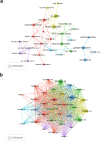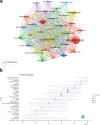Research hotspots and trends in cancer rehabilitation: a bibliometric analysis (2013-2023)
- PMID: 40100306
- PMCID: PMC11919980
- DOI: 10.1007/s00520-025-09355-3
Research hotspots and trends in cancer rehabilitation: a bibliometric analysis (2013-2023)
Abstract
Background: Advances in medical care have made cancer rehabilitation an essential component of comprehensive cancer treatment. However, bibliometric analyses in this field remain limited. This study maps the global research landscape of cancer rehabilitation over the past decade.
Methods: Relevant publications on cancer rehabilitation from 2013 to 2023 were retrieved from the Web of Science Core Collection (WoSCC) database. Bibliometric analysis was conducted using VOSviewer, CiteSpace, and the R package "Bibliometrics."
Results: A total of 6743 publications from 98 countries demonstrated sustained growth, peaking in 2022. The USA (1581 publications) and China (974) led in research output, while the Netherlands recorded the highest citation impact (32.75 citations per paper). Key institutions included the University of Texas MD Anderson Cancer Center (148 publications) and Memorial Sloan Kettering Cancer Center (40.58 citations per paper). Supportive Care in Cancer ranked as the most influential journal. Research efforts primarily focused on exercise interventions (n = 404), quality of life (n = 688), and breast cancer rehabilitation (n = 440). Recent trends highlighted telemedicine, digital health, and breast cancer-related lymphedema.
Conclusion: This analysis highlights the dominance of high-income countries in cancer rehabilitation research and identifies exercise, quality of life, and breast cancer as enduring focal points. Emerging priorities include technology-driven interventions and lymphedema management. However, critical gaps remain, such as the underrepresentation of low-resource regions, limited focus on pediatric populations, and insufficient integration of advanced technologies (e.g., AI, wearables). Future efforts should emphasize equitable resource distribution, evidence-based pediatric rehabilitation models, and scalable technology-driven solutions to address global disparities and improve survivorship care.
Keywords: Bibliometrics; Cancer rehabilitation; Hotspots; Research activity; Trends.
© 2025. The Author(s).
Conflict of interest statement
Declarations. Conflict of interest: The authors declare no competing interests.
Figures









Similar articles
-
Global research trends and focus on immunotherapy for endometrial cancer: a comprehensive bibliometric insight and visualization analysis (2012-2024).Front Immunol. 2025 Apr 8;16:1571800. doi: 10.3389/fimmu.2025.1571800. eCollection 2025. Front Immunol. 2025. PMID: 40264788 Free PMC article.
-
Mapping the Evolution of Digital Health Research: Bibliometric Overview of Research Hotspots, Trends, and Collaboration of Publications in JMIR (1999-2024).J Med Internet Res. 2024 Oct 17;26:e58987. doi: 10.2196/58987. J Med Internet Res. 2024. PMID: 39419496 Free PMC article.
-
Exploring research trends and hotspots on oxidative stress and bronchopulmonary dysplasia: Insights from bibliometric and visualized study.Pediatr Pulmonol. 2024 Dec;59(12):3610-3623. doi: 10.1002/ppul.27268. Epub 2024 Sep 12. Pediatr Pulmonol. 2024. PMID: 39264135
-
Evolution and global research trends of immunity in diabetic nephropathy: a bibliometric and visual analysis from 2004 to 2023.Int Urol Nephrol. 2024 Oct;56(10):3307-3321. doi: 10.1007/s11255-024-04081-x. Epub 2024 May 17. Int Urol Nephrol. 2024. PMID: 38758346 Free PMC article.
-
Bibliometric analysis of global research on vitamins and cancer between 2003 and 2022.Medicine (Baltimore). 2024 Dec 13;103(50):e37108. doi: 10.1097/MD.0000000000037108. Medicine (Baltimore). 2024. PMID: 39686412 Free PMC article.
References
-
- Bray F, Laversanne M, Sung H, Ferlay J, Siegel RL, Soerjomataram I, Jemal A (2024) Global cancer statistics 2022: GLOBOCAN estimates of incidence and mortality worldwide for 36 cancers in 185 countries. CA Cancer J Clin 74:229–263. 10.3322/caac.21834 - PubMed
-
- Miller KD, Nogueira L, Devasia T, Mariotto AB, Yabroff KR, Jemal A, Kramer J, Siegel RL (2022) Cancer treatment and survivorship statistics, 2022. CA Cancer J Clin 72:409–436. 10.3322/caac.21731 - PubMed
-
- Weaver KE, Forsythe LP, Reeve BB, Alfano CM, Rodriguez JL, Sabatino SA, Hawkins NA, Rowland JH (2012) Mental and physical health-related quality of life among U.S. cancer survivors: population estimates from the 2010 National Health Interview Survey Cancer epidemiology, biomarkers & prevention : a publication of the American Association for Cancer Research, cosponsored by the American Society of Preventive Oncology 21: 2108–2117. 10.1158/1055-9965.epi-12-0740 - PMC - PubMed
-
- Stout NL, Silver JK, Raj VS, Rowland J, Gerber L, Cheville A, Ness KK, Radomski M, Nitkin R, Stubblefield MD, Morris GS, Acevedo A, Brandon Z, Braveman B, Cunningham S, Gilchrist L, Jones L, Padgett L, Wolf T, Winters-Stone K, Campbell G, Hendricks J, Perkin K, Chan L (2016) Toward a national initiative in cancer rehabilitation: recommendations from a subject matter expert group. Arch Phys Med Rehabil 97:2006–2015. 10.1016/j.apmr.2016.05.002 - PubMed
-
- Alfano CM, Ganz PA, Rowland JH, Hahn EE (2012) Cancer survivorship and cancer rehabilitation: revitalizing the link. J Clin Oncol 30:904–906. 10.1200/jco.2011.37.1674 - PubMed
Publication types
MeSH terms
LinkOut - more resources
Full Text Sources
Medical
Miscellaneous

